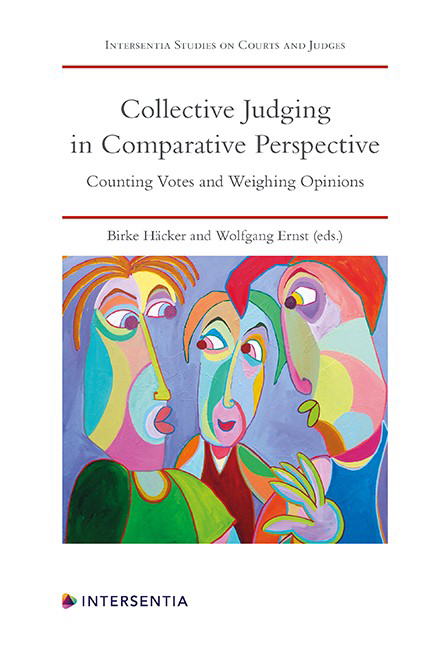Book contents
- Frontmatter
- Preface
- Contents
- List of Cases
- List of Contributors
- PART I DESIGNING COLLEGIATE COURTS’DECISION-MAKING PROCESSES
- PART II COLLEGIATE COURTS IN THE COMMON LAW TRADITION
- PART III COLLEGIATE COURTS IN THE EUROPEAN CIVIL LAW TRADITION
- PART IV COLLEGIATE COURTS IN A NON-EUROPEAN CIVIL LAW JURISDICTION: THE CASE OF JAPAN
- PART V SUPRANATIONAL AND INTERNATIONAL COLLEGIATE COURTS
- PART VI VOICES FROM THE AUDIENCE AND CLOSING REMARKS
- About the Editors
Chapter 15 - Collective Judging in the Catholic Church
Published online by Cambridge University Press: 09 February 2021
- Frontmatter
- Preface
- Contents
- List of Cases
- List of Contributors
- PART I DESIGNING COLLEGIATE COURTS’DECISION-MAKING PROCESSES
- PART II COLLEGIATE COURTS IN THE COMMON LAW TRADITION
- PART III COLLEGIATE COURTS IN THE EUROPEAN CIVIL LAW TRADITION
- PART IV COLLEGIATE COURTS IN A NON-EUROPEAN CIVIL LAW JURISDICTION: THE CASE OF JAPAN
- PART V SUPRANATIONAL AND INTERNATIONAL COLLEGIATE COURTS
- PART VI VOICES FROM THE AUDIENCE AND CLOSING REMARKS
- About the Editors
Summary
To consider collective judging in the Catholic Church presupposes a knowledge of the fact that the Church has her own tribunals, which are separate and independent of the ordinary civil courts and tribunals run by the state. These tribunals are normally situated in dioceses around the world, that is, on the local level; but they are also to be found on the level of the universal Church as tribunals of the Holy See. Regarding collective judging, both types of tribunals are regulated by the same principles, but there are also specific rules when it comes to the tribunals of the Holy See. The rules binding all tribunals within the Church are found in the general law that governs the universal Church, but the tribunals at the local level will be considered first in this chapter.
THE TRIBUNALS OF THE CHURCH AT THE LOCAL LEVEL
In talking about collective judging within the Church, we have to keep in mind, first of all, that in the Catholic Church, the Bishop is the judge. From the very beginning, people came to him to present their cases or to seek his judgment in a controversy, be it ecclesial or civil. The history of law, therefore, shows how great an influence the workings of Church tribunals had on the evolution of general civil tribunals.
A good example of the way in which Bishops exercised their juridical duty is provided by the canon law collection of Regino of Pürm, Libri duo de synodalibus causis et disciplinis ecclesiasticis, a handbook for the Bishop during his visitation of the diocese, first published at the end of the 9th century.
Apart from this general role, which is also emphasised in the Code of Canon Law, the canonical tradition suggests that the Bishop should not act as a judge in person but set up a tribunal to handle controversies. With the Code of Canon Law of 1917, we have an organisation of these collegial tribunals for the whole Church, which is repeated in the revised Code of Canon Law (1983).
It is the Code of Canon Law that determines the working of tribunals in the Church and contains the law binding the whole Church all over the world.
- Type
- Chapter
- Information
- Collective Judging in Comparative PerspectiveCounting Votes and Weighing Opinions, pp. 283 - 290Publisher: IntersentiaPrint publication year: 2020



